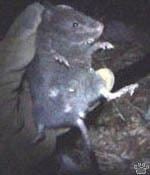Scientific name Geoxus valdivianus Rank Species | Genus GeoxusThomas, 1919 Phylum Chordata Order Rodent | |
 | ||
Similar Chelemys, Rodent, Abrothrix, Euneomys, Abrothrix longipilis | ||
Geoxus valdivianus, also known as the long-clawed mole mouse or Valdivian long-clawed akodont, is a species of rodent in the tribe Abrotrichini of family Cricetidae found in the Valdivian temperate rain forests and Magellanic subpolar forests of Argentina and Chile. It is the only species in the genus Geoxus. Molecular data suggests that its closest relative is Pearsonomys annectens.
Contents
Description
The long-clawed mole mouse is a small shrew-like mammal with a short tail and a total length of about 14 cm (5.5 in). The body is spindle-shaped, enabling this mouse to move and turn in confined spaces. The pelage is short and velvety, dark olive-brown to black, sometimes tinged with reddish brown. The snout is pointed, the eyes small and the ears tiny. The feet are large, the claws being larger than the digits.
Distribution and habitat
This species is endemic to the southern tip of South America. Its range extends from southern Argentina and central Chile, including Mocha Island and Chiloé Island, to the Strait of Magellan. Its habitat is the forests of Nothofagus, Saxegothaea and bamboo found in this region, as well as tussock grassland, marshes and wet meadows; its altitudinal range is from sea level to the tree line.
Behaviour
The long-clawed mole mouse digs a burrow and also moves about in surface runways near fallen logs and in dense undergrowth. It is mainly nocturnal, leaving its burrow briefly to feed on earthworms and other small invertebrates, supplemented by plant material.
Status
G. valdivianus is an uncommon species but it has a wide range and no particular threats have been identified; the International Union for Conservation of Nature has assessed its conservation status as being of "least concern".
